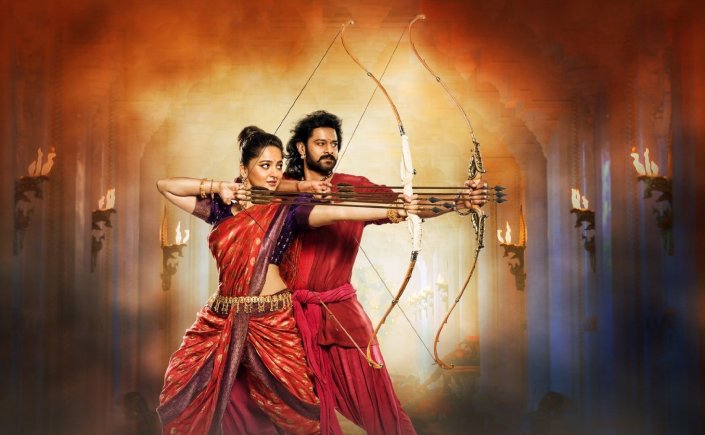
Photo by Great India Films
Director: S. S. Rajamouli
Starring: Prabhas, Rana Daggubati, Anushka Shetty, Sathyaraj, Ramya Krishnan, Nassar
“Baahubali 2: The Conclusion,” aka “Why Kattapa Killed Baahubali: The Movie,” takes us back to the story of Amarendra and his son Mahendra Baahubali, both played by Prabhas in a dual role. While the film’s predecessor, “Baahubali: The Beginning,” introduces the audience to all the characters and sets Mahendra off on his quest for revenge against his uncle Bhallaladeva (Rana Daggubati), the sequel predominantly focuses on the events that led to the demise of Amarendra, and Mahendra finally learning the truth about his father and saving the Mahishmati kingdom from his evil uncle.
“Baahubali 2” had huge shoes to fill as a follow-up to the supremely successful first part. The expectations have never been higher for a regional movie to deliver a story that would be qualitatively equivalent to its predecessor and surpass it in every way possible. With this film, S. S. Rajamouli pulls off the impossible. He not only manages to capture the essence of the first film in its entirety, but he also adds certain nuances to keep things fresh. It surprisingly doesn’t suffer from the “Been There, Seen That” syndrome that sequels typically go through. “Baahubali 2” doesn’t necessarily surpass its predecessor, but it certainly holds up to the extremely high standards that were set by the original.
A large chunk of the film is simply a buildup to the moment everyone has been talking about for the last two years. Although it’s not excruciating to watch the events gradually unfold until the answer to the universally-asked question is finally revealed, it still is no walk in the park. Most of the first half is filled with mediocre humor, which doesn’t progress the story or work in the favor of the characters in any way. The story initially latches on to certain characters who are neither interesting, nor crucial to the overall arc. This time could have easily been used to further develop a real sense of connection between Amarendra and Kattappa. Amarendra’s relationship with Devasena, played by Anushka Shetty, and Kattappa, played by Sathyaraj, is slightly entertaining to watch, but his dynamic with most of the other characters remains flat throughout the movie.

Photo by Great India Films
Since most of the film acts as a prequel, it doesn’t have to depend upon its intertextuality with the first movie. One major character studied more deeply in this part is Amarendra’s mother, Maha Rani Sivagami (Ramya Krishnan). Whereas in the first part she is seen fearlessly fighting men to save her grandson, in the sequel she can be perceived as a flawed character who lets her pride and responsibility towards the kingdom get in the way of the happiness of his son. When it comes to performing this character, Krishnan overdoes it in a handful of scenes, which might take some audience members completely out of the narrative. However, she works like a charm for the majority of the film. Rana Daggubati, Anushka Shetty and Sathyaraj are great in bits and pieces, but they certainly have their flaws. While some actors struggle with their performances, Prabhas is a saving grace. His leading performance carries this movie on his shoulders, making Rajamouli’s vision a reality while being surrounded by a pool of mediocre performances.
The film is being sold as a visual masterpiece, which is true for the most part. There are some wonderfully shot scenes throughout the movie which really capture the imagination of the artists and create a new landmark for visual storytelling in Indian cinema. Although the build-up might not be exciting to experience, the scene in which we finally find out why Kattapa killed Baahubali is worth the wait for its utterly flawless visual bliss. The scene is shot in as wide an angle as possible, with perfect musical accompaniment, letting the audience consume the bitter reality of the situation. It is pure cinematic brilliance. While there are some gloriously shot scenes, there are also quite a few noticeably wonky ones which can be ignored, but certainly can’t be unseen.
“Baahubali 2: The Conclusion” proves that S. S. Rajamouli is a director who will be praised for years to come, for creating something which had never before been attempted in Indian cinema.


